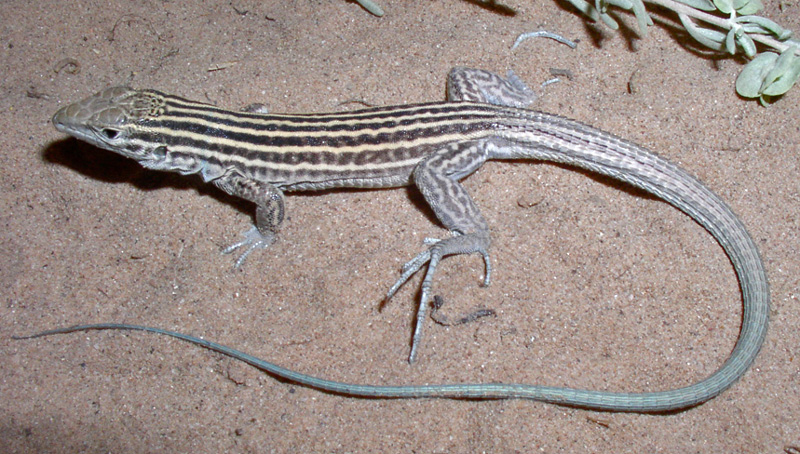Sex and Single Lizards
Charles J. Cole

Jay Cole and Bob Bezy, Organ Pipe Cactus National Monument, ca 2004. Photo by Kathryn Bolles
It’s the summer of 1966. Yesterday, John Wright breezed through Tucson and dropped off a couple of the all-female New Mexico Whiptail Lizards at Lowe’s lab. These were for me to karyotype and see whether their chromosomes indicated a hybrid origin, as would be the case in certain plants. I immediately prepped the lizards and the lab for the next afternoon’s run.
The run went well—metaphase spreads all over the slides, and I rushed home for dinner. It was our anniversary, and I’d been working hard all year, my first in Lowe’s lab, day and night, weekends and holidays, and during the week my wife had begged me to stay home tonight and celebrate.
We grilled steaks for dinner, and the phone rang just as we sat down to eat. It was Lowe. “Jay, it’s a hybrid!” “That’s fantastic, Dr. Lowe, but be careful because the mounting medium hasn’t dried on the slides yet!” “Come up to the lab so we can work out all the details together!” “It’s our anniversary, Dr. Lowe, and I promised my wife several days ago I’d stay home to celebrate.” “You’ve got to come up to the lab—this is fantastic!” “I’ll be there at 8:00 tomorrow morning and we can spend all morning together studying the slides. See you tomorrow.”
The next morning I went to the lab not knowing what to expect since I had broken three major lab rules: (1) always obey Chuck’s command, or at least lead him to think that’s what you’re doing; (2) especially, don’t ever tell Chuck “no”; and (3) never suggest that the Chief should come to the lab before 10:00 or 11:00 a.m., especially while disobeying his command to come now! If I wasn’t wanted on the chromosome team, I’d be dead meat (Lowe called me “the man with the golden arm” because of the way I shook residual fixative off the slides after flame-drying). And I knew that someday, somewhere, I’d notice repercussions about this, as Lowe was so excited he needed somebody there to share in the experience and I let him down.

Jay Cole examining chromosome slides, ca 1967, University of Arizona, photo by Oscar Soule
I arrived in the lab early the next morning. Beside the microscope were some sketches of chromosome spreads in cells that Lowe drew the night before. This really surprised me, as I had never seen him working at the compound microscope and he got it right without messing anything up, even though the coverslips had not finished cementing onto the slides while he worked.
Our paths didn’t cross for a week or more after that phone call, as I completed data collection, comparisons, and photography of the material. Then one morning around 9:30 when clearly it was too early for Lowe to be in the lab, I took the forbidden short-cut from one hallway to another through the ecology teaching lab, which by then Lowe had made into an extension of his office. There were piles of books and reprints everywhere. I got half way through the room when suddenly his voice rose up from behind some piles of books: “Sex has its place alright, but once a week on Saturday night is enough!” Saying nothing, I quickened my pace and walked through, eyes on the floor.
My biggest concern was the usual one about whiptail lizards at the time. Lowe and Wright were extremely anxious to publish on this before Maslin’s Colorado team might. Publishing a great idea first was the highest priority. Completing the best science was secondary. I knew, as Lowe and Wright did, that we ought to get additional specimens from a more distant locality, where the two parental species did not also occur, and we could accomplish this in less than a week. Otherwise, we did not really know whether the two specimens examined were really clones of an all-female species or just new F1 hybrids. Also, the craziness around and between Lowe and Wright bothered me. I was certain that John disliked my success with the chromosome preparations, done with slight modification of Jim Patton’s most successful method for small mammals--the basis of our work. Without Jim’s technique we would have had nothing.
One night when John was telling me many of his stories of paranoia about other personalities, I mentioned that “by the way, don’t suggest to Lowe that I should be a coauthor on the hybrid origin paper unless he brings it up.” And on a separate occasion, I told Lowe, “by the way, don’t suggest to John that I should be a coauthor on the hybrid origin paper unless he brings it up.” I never saw the manuscript, which was submitted to a local outlet for immediate publication.
When the paper appeared I was not a coauthor, but Jim Patton and I were acknowledged “for their generous assistance with the laboratory phases of the work involving the laborious stages of processing large numbers of animals (Methods and Materials).” In the list of specimens examined was an additional specimen of the New Mexico Whiptail Lizard from a more distant locality of non-sympatry with the parental forms, and it was a specimen I had never seen.

New Mexico Whiptail Lizard, Aspidoscelis neomexicanus. Photo by Kathryn Bolles.